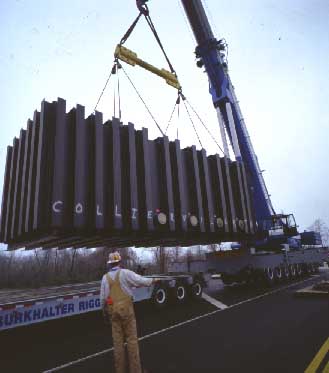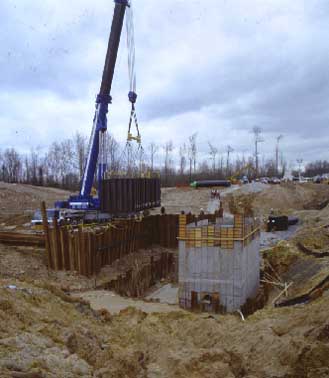Moving huge pump station across five states part of facilities expansion plan

By Ian Lisk
Editor Emeritus, Public Works Online
A very large prefabricated, self-contained pump station was the key component of a wastewater construction project undertaken recently by the community of Collierville, TN.
The 140,000-lb. structure was designed and built in South Dakota, transported over the road through five Midwestern states, and finally installed at the Tennessee facility.

The prefabricated pumping station is lifted off the transporter vehicle after its slow five-day journey across five Mid-western states.
Located 15 miles east of Memphis, Collierville is said to be the fastest growing municipality in the state. In just 14 years, the city's population has grown from 10,000 in 1984 to nearly 40,000 today. A significant development was announced in 1996 when Federal Express, the pioneering overnight package delivery air carrier, which has its hub facility and headquarters in Memphis, decided to locate a new technical services unit in Collierville.
The infrastructure expansion was needed when it became obvious that existing capacity could no longer keep up with this dynamic growth.
This new building houses the company's computer and information systems hardware and activities, and eventually about 1,100 employees will work there. As Jack Tyler, who heads Memphis-based Jack Tyler Engineering Company explained, this could actually add 4,000 to 5,000 residents to the community. And Tim Verner, principal of Fisher and Arnold, Inc., the Memphis engineering firm that has worked under contract with Collierville on the project since 1994, added that going ahead with a new FedEx facility definitely accelerated the need for increased wastewater treatment capacity in the area.
Sudden growth meant wastewater infrastructure had to be enlarged
Tyler said that Collierville City Engineer Robert Gibbons and the Fisher & Arnold team quickly realized that the existing wastewater collection and treatment facilities would soon not have sufficient capacity to handle the anticipated increased loads. So Gibbons and city staff and officials decided that a major expansion was required, one that would call for new interceptor sewerage, a new wastewater treatment plant, and a large pumping station.
The city had gained positive operating experience with prefabricated underground pumping stations installed previously in the wastewater system, and the staff and their consultants opted for a high capacity underground station versus an open-top wet well installation. Running virtually in silence, odor-free and out of sight, the proposed system would cause no threat or be a nuisance to nearby residents.
The new pumping station incorporates submersible pumps operating in a dry well. Gravity-fed influent is made up of wastewater from nearby residential and commercial developments, and the pumps propel the waste stream to the newly constructed Wolf River Wastewater Treatment Plant about four miles away.
Underground pumping station equipped with submersible pumps
The core of the prefabricated pump station comprises three ITT Flygt CZ3231 150 hp submersible pumps. A fourth pump can be added to the station as needed, possibly within five to 10 years. The entire unit, weighing some 140,000 pounds and buried 40 feet below grade, is 39.5 feet wide, 14.5 feet deep and 11 feet high. The assembled station includes variable frequency drives for the pumps, air conditioning, heating, all internal inter-connecting piping, and a vertical maintenance elevator.
Given the compact design, the submersible pumps chosen for the installation had to operate horizontally while lying on their side. Tyler described the configuration of the station as unusual. He said, "We married submersible technology with a below-ground dry well installation. Of course, should there ever be any flooding, the submersible pumps would face no operational problems coping with such a situation."
Wastewater is conveyed to the treatment plant by the Nonconnah interceptor, and travels by gravity through 36-in. and 48-in. diameter pipes to a 40 x 16 x 16 ft concrete wet well constructed as part of the project. Situated just 4 ft away and parallel to the pump station, the wet well is connected to the three pumps in the station by 14-in. diameter pipes.
Pump speeds controlled to match influent and effluent flows
The pump control unit uses an air bubbler system for sensing level in the wet well. When the liquid level rises to the preset "level on" position, a pressure switch is activated causing the first pump motor to start. If the waste stream inflow to the wet-well does not exceed the maximum pumping rate of the first pump, the motor speed is automatically controlled by an adjustable frequency control system connected to a pressure transducer that senses level. The design calls for the station's discharge flow rate to always match the influent rate to the wet well.
If the flow into the wet well increases beyond the capacity of the first pump, the second pump is started. The third pump kicks in only when the flow exceeds the capacity of the first two pumps. As the wet well level decreases, all pumps decrease in speed until all are pumping approximately at half capacity. Shut down of the back-up pumps then occurs and the first pump continues to operate until the wet well level reaches a point where the first pump is shut down.
An 18-in. force main now connects the pump station to the Wolf River Treatment Plant. A second 30-in. force main is in place to handle the higher flows that will bring the third pump into operation. These force mains were laid approximately eight feet below grade over the 17,000-ft connecting distance.
According to Verner, depending on the combination of force mains in use and the number of pumps operating at any given time, the flow rate varies from 1,500 gpm with one pump online, to over 9,000 gpm with three pumps operating, and utilizing both force mains. He said, "We needed a pump station which could be flexible enough to meet relatively low initial demands and be able to grow with the town as the needs dictate by merely switching to a different force main or putting another pump online. The combination of Flygt pumps and dual force mains allows us that flexibility."
Huge factory-built pump station transported through five states
Louis Sebert, general manager and co-owner of Dakota Pump, Inc. of Mitchell, SD, said the $500,000 Collierville pump station was among the largest his firm has produced. He believes the unit's ¾-in. thick steel walls and 49 lb/ft steel beams, all double welded, will ensure leak-proof operation and provide long and dependable service to Collierville residents and businesses.
Moving the pumping station to its installation site proved to be a significant challenge. Weighing 140,000 lbs., it was loaded on to a wide trucking rig and slowly made its way from South Dakota through Iowa, Illinois, Kentucky and finally into Tennessee. A series of special state permits had to be obtained for this roughly 900-mile, five-day journey. Only two-lane highways were used and the rig could be moved solely between 8 a.m. and 3 p.m.

Construction workers watch as the pump station is lowered into position alongside the partly completed poured concrete wet well.
At the hilly construction site a large pit had been dug out of the slope by a crew from Rose Construction Company of Covington, TN. A 450-ton crane was used to lift the pump station off the transporter vehicle and set it in place alongside, and just four feet from, the new 250,000-gallon wet well. This concrete structure has two pipe inlets for receiving wastewater from the Collierville collection. One is a 48-in. diameter pipe coming from the east, the other a 30-in. diameter pipe from the west that will handle anticipated future demands.
Jack Tyler, whose firm represents ITT Flygt Corporation and Dakota Pumps, Inc., derived satisfaction from the fact that the city acted upon his suggestion that thousands of dollars could be saved by calling for separate bids for the pump station and for the excavation and installation work. This move avoided the construction contractor's markup on the equipment.
Now operating as part of the new wastewater facilities serving Collierville, the prefabricated pump station is quietly handling current flows. But it is ready to handle future demands that likely will arise from the continuing growth in the area.
For more information on this project, contact L. P. McDonnell at 203-380-4700.
